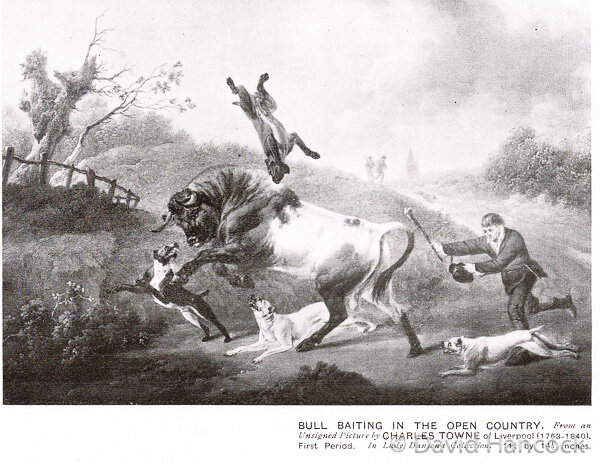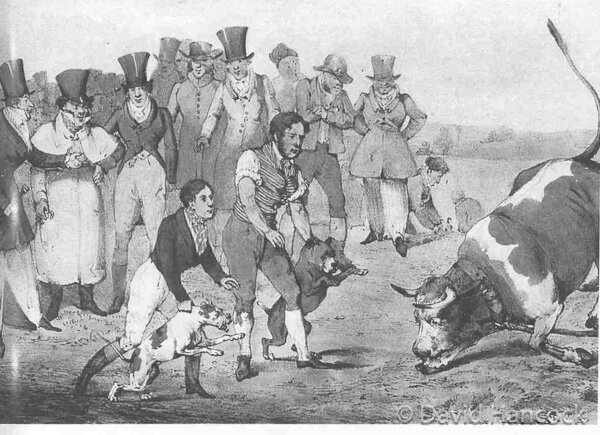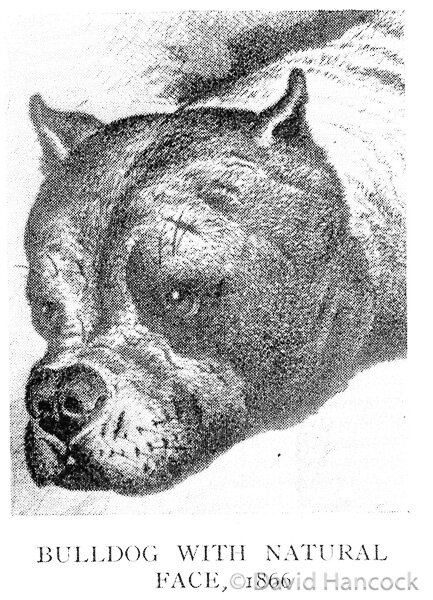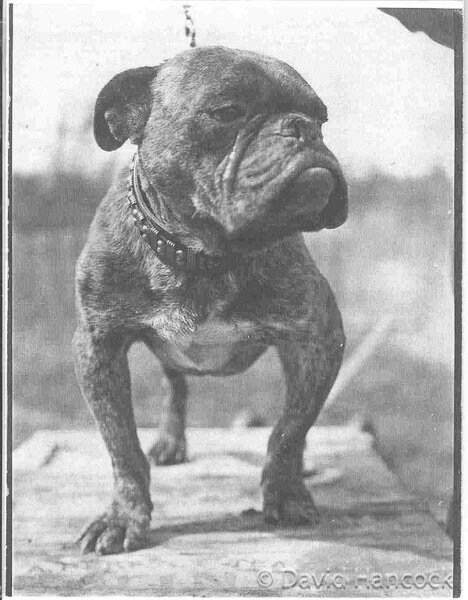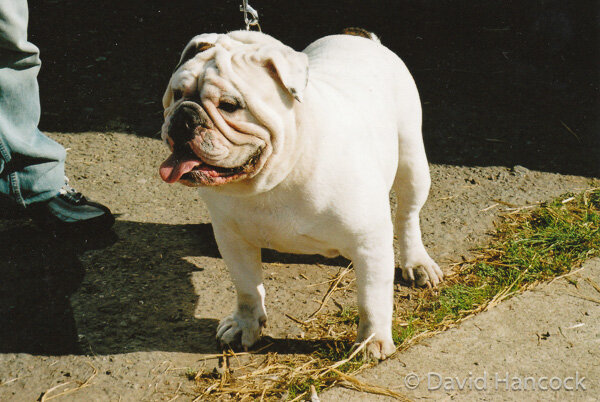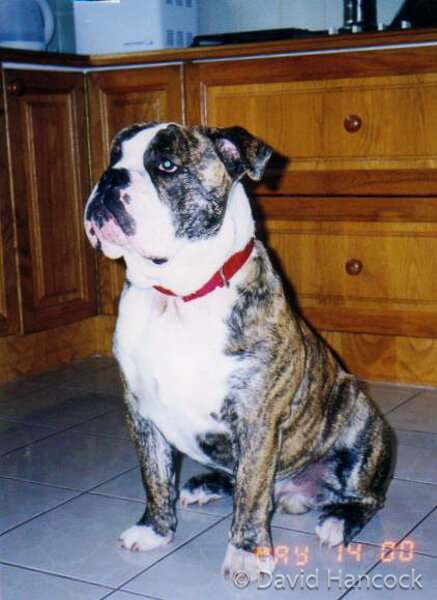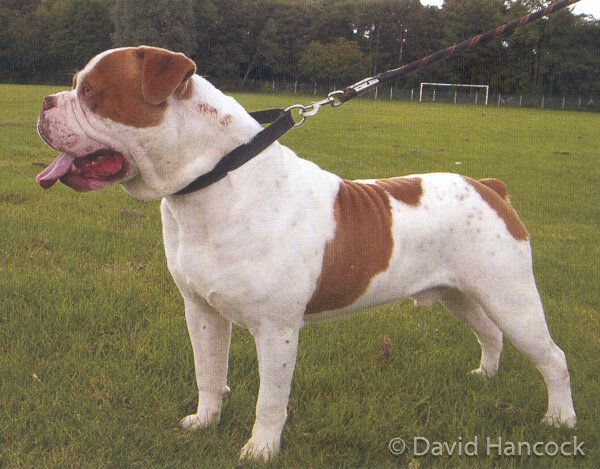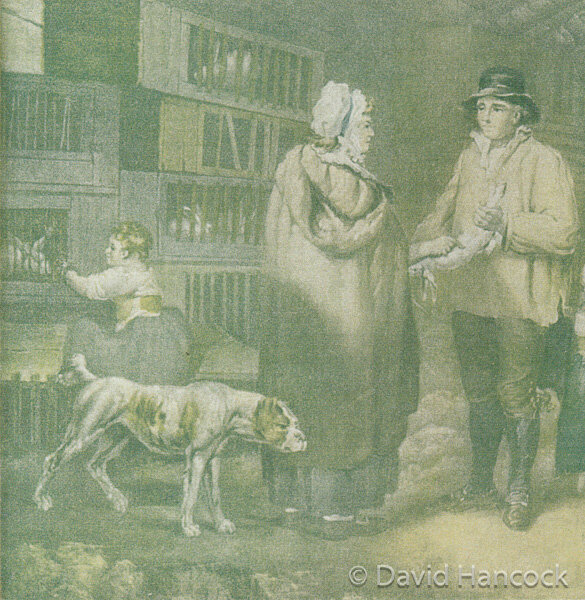1179
MUZZLING THE EVIDENCE – HARMING THE BULLDOG
By David Hancock
"Anyhow, the Bulldog of today is an entirely different animal, both physically and mentally, from the Bulldog of fifty years ago. Then he was a leggy, terrier-like, active brute...As to whether the fancier has improved the breed constitutionally is a moot point. Type has certainly been made more uniform; but this in many cases has been at the expense of other qualities."
'British Dogs' by WD Drury, 1903.
The Demands of Baiting
Farmers have long needed, to support the herding dogs, powerful, determined dogs to ‘pin’ or ‘grip’ wayward cattle, and the broad-mouthed type were ready-made for the task. The barbaric sport of bull-baiting demanded the production of savage, ferocious, fearsomely aggressive dogs. Any thirty-pound dog prepared to attack an enraged one-ton bull has to be both extraordinarily brave and almost irrationally determined, potentially valuable characteristics but not ones without dangers. A savage, aggressive, recklessly-brave dog, however much admired in its time, has a more limited future once an unpleasant recreation like bull-baiting is discontinued. Writing in his "The Bulldog - a Monograph" of 1899, Edgar Farman observed that: "From that time forward the breed began to deteriorate, and, with the era of modern dog shows, the appearance of an up-to-date specimen became a caricature of the active and plucky animal that baited the bull". This 'caricature' has sadly become the model for this admirable breed and harmed the breed for over a century.
Promoting Incapability
In his 'The British Dog' of 1888, Hugh Dalziel quotes the Bulldog and Mastiff fancier Adcock as stating: "In such a combat (i.e. bull-baiting) as this, it is needless to point out that the toy dog at present cherished by a few as the English Bulldog is - notwithstanding he is frequently possessed of unflinching courage - quite incapable of the part assigned him by Claudian and the subsequent writers; indeed, the dwarfed body and limbs would not only prevent his ever being able to catch an active and unfettered bull, but would also deprive him of the ability to make good his escape should he feel so disposed, whilst the absurd, excessive, and unnatural shortness of face would render a firm and lasting hold almost an impossibility." It is difficult to disagree with that last sentence. The pinning/gripping dogs and then the baiting dogs were bred for performance, however regrettable, the show dogs were bred to suit human whim, not their physical comfort. The Japanese Tosa engages in a ‘gripping contest’, mouth-wrestling, rather than a savage dog-fight; the Bulldog, like the Tosa, could never be a fighting dog using bite and a tearing action, instinct and physique quite apart.
"...the bulldog was too slow for fighting...he could not get a mouth on quickly. Again, you must not confuse him with the modern creation, for man has so improved the short nose that these poor brutes can now hardly pick up their own food."
from 'Fighting Sports' by Captain L Fitz-Barnard (Reprint 1971)
Crippled Abnormal Dogs
The last quarter of the nineteenth century sounded the death knell for the old bull-baiting type of Bulldog. In his "Dogs: their History and Development" of 1927, Edward Ash wrote: "When bull-baiting...ended, the dog was bred for 'fancy', and characteristics desired at earlier times for fighting and baiting purposes were exaggerated, so that the unfortunate dog became unhappily abnormal. In this translation stage, huge, broad, ungainly heads were obtained, legs widely bowed were developed, and frequently the dog was a cripple." In the pursuit of a smaller, less aggressive animal, breeders resorted to the blood of the Pug, an equable companionable breed of great charm. No depiction of baiting dogs shows them featuring the short face. It's an inaccurate, quite needless, infliction.
The Introduction of Pug Blood
I know of only one book on the pure-bred Bulldog that acknowledges this cross and describes its undesirable consequences. This is the first book devoted to the breed, Robert Fulton's 'The Bulldog' of 1889, in which he states: "...I firmly believe the pug was in a measure used, judging from the structural formation of many specimens." It is flatly denied by Bulldog breeders today but all the authoritative writers on dogs at the end of the last century and at the start of this: Vero Shaw, Rawdon Lee, Sydenham Edwards, Robert Leighton and the celebrated 'Stonehenge', state that it did. How can any breed prosper in an atmosphere of deceit and harmful concealment? Outside blood can have value but only when it is planned for improvement rather than from some influential clique's whim. Bulldogs had to be swift, agile and athletic just to survive in the appalling world of baiting animals. The disgraceful treatment meted out to the baited animals gives you some idea of the so-called human beings involved in such barbarity. There are records of bears having their claws and teeth ripped out, bulls having hot oil poured in their ears, black pepper being thrust up their nostrils, having not just their tongues and noses cut out but their forelegs cut off to lower their height. Most of the baiting dogs suffered too. An inability to breathe and impeded movement from straight stifles delivers suffering too!
Discomfort and Disadvantage
Some well-informed commentators, especially around Crufts time, suggest that the design of the Bulldog of today inflicts discomfort and disadvantage on the breed amounting to cruelty. Simon Wolfensohn, a practising vet, writing in the New Scientist two decades ago, listed, in the breed of Bulldog: respiratory problems due to the short nose, dental problems due to the short jaw, protrusion of the upper or lower jaw, skin infections due to bacteria becoming trapped in the folds of the skin and problems giving birth. The authoritative "Medical and Genetic Aspects of Purebred Dogs" edited by Clark and Stainer, published by Forum Publications USA in 1994, states that only 6% of bitches whelp naturally, that of 707 pups delivered in 150 caesarean sections 37 had cleft palates and 58 of them died of walrus syndrome (three times normal birth weight). The book describes as "one of the most devastating conditions found in the Bulldog" foreleg lameness caused by loose shoulder joints and leading to severe chronic strain on the shoulder and elbow joints, resulting in debilitating foreleg arthritis. Since the Breed Standard requires the Bulldog to have forelegs set wide apart and elbows which stand well away from the ribs, such a problem is scarcely surprising. As this breed standard demands a dog with a massive head and hindquarters lighter in comparison with heavy foreparts, natural whelping is hardly assisted. I recently saw a ‘re-created Bulldog’ that closely resembled the 1798 specimen once depicted – and it looked so impressive.
Impeded Powers of Locomotion
In his The Bulldog – A Monograph of 1899, Edgar Farman wrote: "The early show Bulldogs were not so cloddy as the exaggerated specimens now are, they were not so heavily built that their powers of locomotion were impeded..." The "powers of locomotion" of the Bulldog are not exactly helped by the wording on gait/movement in the breed standard: peculiarly heavy and constrained. Why would anyone want their dog to walk in a strangely cumbersome and unnaturally forced manner? Or is this inevitable when the standard demands forelegs wide apart, elbows which stand well away from the dog's ribs and hocks "made to approach each other", with stifles "round" (if that is physically possible). The biggest handicap to the modern non-sporting Bulldog is not so much in its unnatural movement but in its untypically short muzzle. It is significant that in those bulldog breeds developed outside Britain from stock taken there several centuries ago do not feature a muzzle-less head. The American Bulldog, the Alapaha Blue Blood Bulldog, the "Olde Englishe Bulldogges" of Lolly Wilkinson in Vancouver, the 'Aussie Bulldogs' of Noel and Tina Green and the Ca de Bou or Majorcan Bulldog all have strong but balanced skulls, with appreciable muzzle length.
Faulty Breed Blueprint
The main problem met by Bulldog breeders, exhibitors and show judges in the last century or so lay in the wording of the Breed Standard, authorised by the Kennel Club as the design for the breed. Until recently heavily amended, this detailed description of what the breed should be like had over 250 words on the head and skull but only 30 on movement and 13 on temperament. Some of the requirements were simply a recipe for disaster: "Head massive...body short...skull large...skin upon and about head, loose and wrinkled...muzzle short...eyes well away from ears...shoulders giving appearance of being 'tacked on' body...elbows standing well away from ribs...movement - peculiarly heavy and constrained". It could have been drafted by someone who hated Bulldogs! Not surprisingly, the resultant contemporary Bulldog is an anatomical disaster. The harm has been done. The above-quoted words shaped today's breed!
Distressing Consequences
As a direct result of this harmful, long-lasting design specification, we have a breed of dog that is quite unlike its own ancestors, has distressing respiratory problems, cannot give birth naturally and is unable to live a normal life. Could anyone claiming affection for a breed really want its gait to be "peculiarly heavy and constrained"? I can understand fanciers wanting to perpetuate a breed as it was originally; but how can any pure-bred Bulldog breeder not only want to produce crippled dogs but dogs that are so physically different from their own forebears? It can only be explained by a selfish and unfeeling fascination with deformation. It is noteworthy that Bulldogs developed here by non-show breeders and known as Sussex, Dorset or Victorian Bulldogs do not feature the exaggerations desired by those showing in KC-sanctioned rings. Breeding for the health of your chosen breed should be part of breed-loyalty.
Absurd Wording
The Bulldog Breed Standard has historically drawn disapproval. In 1888, it was being accused, by a well-known breeder, Adcock, of being: "absurd...founded upon no basis...been foisted upon breeders...in advocating the production of a small, thin ear, he is unconsciously but certainly diminishing the thickness and volume of the skin covering the head and neck, so necessary for the protection of an essentially gladitorial animal...the tail must be destitute of rough hair, which practically means that the coat of the dog must be of an extremely fine nature...this peculiarity tends to, and has actually resulted in, diminution of the bony structures; the inferior dentition; and weakness of constitution." Certainly, today's pure-bred Bulldog suffers from a number of problems created by its own approved design.
Re-creating the Real Bulldog
A number of worthy people have attempted to re-create the genuine Bulldog. Clifford Derwent, himself a successful dog breeder of other breeds, exhibitor and highly rated judge, developed what he called Regency Bulldogs. But he couldn't get the temperament right and abandoned his admirable quest. Then the late Ken Mollett of Pinner took up the challenge, with some success. Using a blend of Staffordshire Bullterrier, Bullmastiff and oversized pure-bred Bulldog, he stabilised his own distinct Victorian Bulldog type: active, agile, unexaggerated and yet unaggressive. He deserved greater support. The physical condition of our pedigree Bulldog is a matter screaming out, on humane grounds alone, for action by the Kennel Club. Yet despite their ownership of the harmfully worded Breed Standard, they see it as a matter for the breed clubs. But why should the latter change when their members can sell their pups for £600-£800 each? I have also seen 'Sussex Bulldogs' and 'Dorset Old Tyme Bulldogges', currently being bred by well-intentioned fanciers, that looked healthy and unexaggerated, active and agile, breathing and moving freely.
These Dorset Bulldogge fanciers are producing active athletic dogs which live long healthy lives and look real characters. The Dorset Bulldogge breeders are seeking a dog standing around 20 inches at the shoulder, ranging from 60 to 90 lbs, stocky, well-muscled, with a muzzle long enough to permit good respiration and a torso which allows natural whelping. The Sussex Club’s breeding programme is over 30 years old, and any randomly chosen Sussex Bulldog has a minimum of 12 generations behind it. They are now breeding for 20th generation dogs. The Sussex Bulldog breeders are seeking an unexaggerated dog standing around 22-24 inches at the shoulder, ranging from 105 to 120 lbs, sturdy, powerfully-developed, with a muzzle between a third and a fifth of the skull length, which should allow natural whelping.
Re-created Breed
Rumour has it that a group of continental Bulldog fanciers have approached the international kennel club, the FCI, with a request for a 'Continental Bulldog' to be recognised by them. This 'new breed' will apparently be a reversion to the old-style more athletic one, depicted in old prints and paintings, lacking the muzzle-less head, wide forefront and narrow hips of the KC-recognised breed, favoured in the show-ring here. As indicated above, an English breeder once attempted to re-create the older type, calling them Regency Bulldogs. More recently, as previously mentioned, the late Ken Mollett and his Victorian Bulldog Society members have pursued a comparable project. In Switzerland, Holland, Australia, the United States and Canada, other talented and well-intentioned breeders have produced less exaggerated specimens, with mixed success. It would be shameful surely if overseas breeders managed to produce a Bulldog, and get it registered, which more faithfully portrayed our much-loved native breed. The KC Bulldog is the saddest of sad commentaries on the harm that can be inflicted on a breed by wholly misguided fanciers, heedless of the breed’s discomfort and limited life. Shame on them!
In his ‘Bulldogs and all about them’ of 1925, Barrett Fowler wrote: "...a vast number of crippled, unhealthy and grossly exaggerated specimens of the breed were being exhibited, and what is worse, winning prizes...It was the aim of some breeders to produce the most exaggerated specimens possible. They misread the Standard and taught others to misread it also."
A writer for The Farmer’s Magazine gave the following view of the breed of Bulldog as seen by the farming community; it is not flattering!
THE BULL-DOG
The Bull-dog is low in stature, deep chested, and strongly made about the shoulders and thighs, the muscles of both of which are extremely developed.
His head is broad, his nose short, and the under-jaw projects beyond the upper, which gives him a fierce and disagreeable aspect. His eyes are distant and prominent, and have a peculiar suspicious-like leer, which, with the distension of his nostrils, gives him also a contemptuous look; and from his teeth being always seen as the constant appearance of grinning, while he is perfectly placid. He is the most ferocious and unrelenting of the canine tribe, and may be considered courageous beyond every other creature in the world, for he will attack any animal, whatever be is magnitude.
The internal changes which determine the external changes which determine the external characters of this dog, consist in a great development of the frontal sinuses, a development which elevates the bones of the forehead above the nose, and draws the cerebral cavity in the same direction.
But the most important quality, and that, perhaps which causes all the others, although we cannot perceive the connection, is the diminution of the brain. The cerebral capacity of the bull-dog is scarcely capable of any education, and is fit for nothing but combat and ferocity.
This animal takes his name from his having been employed, in former times, in assaulting the bull, and he is used for the same purpose at the present day, in those districts where this brutal amusement is still practised.
Nothing can exceed the fury with which the bull-dog falls upon all other animals, and the invincible obstinacy with which he maintains his hold. In attacking the bull, he always assails him in front, and generally fastens jupon his lip, tongue, or eye, where he holds and hangs on, in spite of the most desperate efforts of the other to free himself from his antagonist, which affords ample proof of the amazing strength and power of this animal.
Whenever a bull-dog attacks any of the extremities of the body, it is invariable considered a mark of his degeneracy from the original purity of blood. Puppies will assail a bull, and thereby give a decided proof of their breed, when only six months old; and, if permitted, will rather suffer themselves to be destroyed than relinquish the contest.
Although this trial is sometimes made with the whelps of a particular litter, to demonstrate the purity of their descent, and to prove that there has been no improper cross the future fame of their posterity may be affected, yet they are seldom entered in a regular ring until from fifteen to eighteen months old. But their ligaments cannot be considered as at their full strength until they are at least two years old. Indeed, amateurs say, that they are not at their prime until they have attained four or five years of age.
The bull-dog is admitted by naturalists to be one of the original and peculiar races of Britain, and may be ranked, in in point of originality, with the shepherd’s dog and Irish greyhound. In various districts in England this breed is still preserved in its native purity, by that class of people who delight in bull-baiting and fighting of dogs, both of which amusements, alike inhuman, are now happily on the decline. – Brown.



